Apple watch 7 review a slight upgrade compared with crossword apple watch 7 review a slight upgrade compared in spanish apple watch 7 review a slight upgrade compared with felix apple watch 7 review a slight upgrade mac apple watch 7 review a slight trick apple watch 7 review a slight edge apple watch 7 review a slight definition apple watch bands apple watch series 3
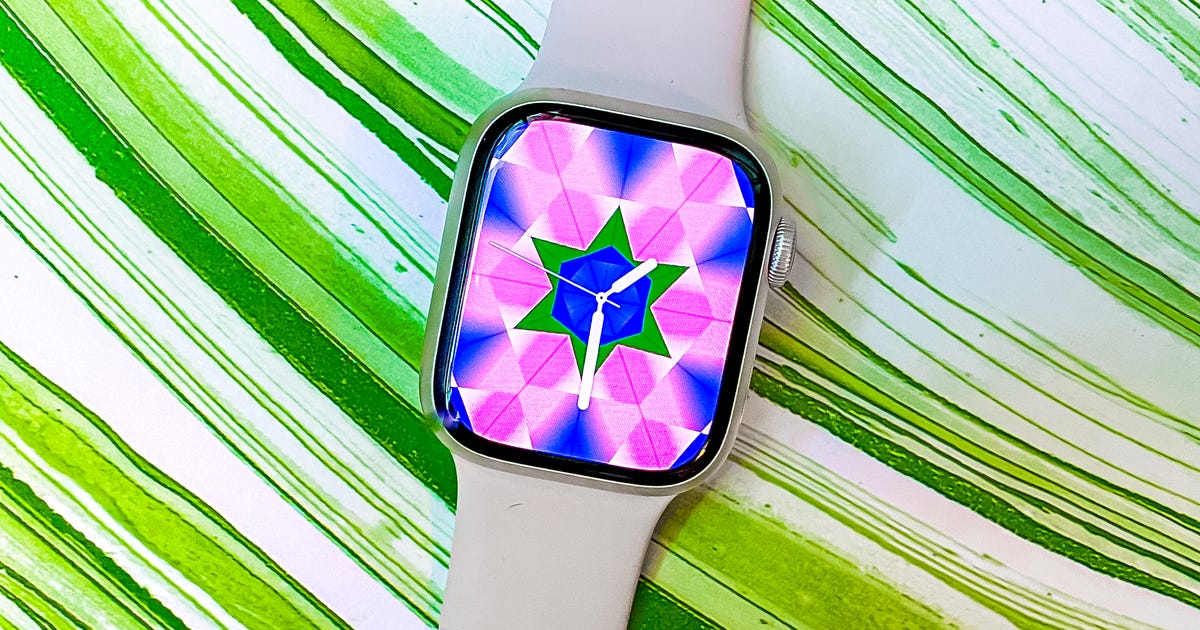
Apple Watch 7 review: A slight upgrade compared to last year's smartwatch
Editor's note, Nov. 2: The Apple Watch Series 7's larger screen and faster charging make an already great smartwatch even better, which is why we've given it a CNET Editors' Choice Award. Our original review follows.
The Apple Watch has long been considered the gold standard of smartwatches, and that holds true with the Series 7. There isn't much that separates it from the Series 6, but that's not necessarily a drawback. The Series 6 already offered a polished software experience, sleek design and plenty of useful fitness features, and Apple has further refined those attributes with the Series 7.
It introduces a larger screen with a QWERTY keyboard for the first time, new color options, faster charging and improved durability for the same price as the Series 6. Of course, it's not perfect -- the battery life hasn't improved, and Apple's sleep tracking still generally lags behind the competition. But it's undoubtedly the best smartwatch for iPhone owners, which is why we give it the best ranking.
While the enlarged screen is the Series 7's most significant change, there are a few other update worth noting. The design is more durable and dust resistant for the first time, it can charge up to 33% faster than the Series 6 and the aluminum casing comes in new color options.
Otherwise, the Apple Watch Series 7 has all the same goodies as the Series 6, including the more premium features missing from the Apple Watch SE like blood oxygen saturation measurements, an always-on display and the ability to take ECG measurements from the wrist.
To put it bluntly, the Series 7 doesn't feel like the type of generational upgrade we've come to expect from Apple's smartwatches in years past. But that's not necessarily a snub against it.
The Series 7 feels more like a refined version of a watch we already love -- the Series 6 -- rather than a major upgrade. And since it's the same price as its predecessor, the Series 7 is a promising option for first-time Apple Watch buyers or those upgrading from an older watch.
If you have a Series 6 or a Series 5, don't spend $400 on the Series 7. But if you have an aging model like the Series 3, Apple's latest watch will feel like a noticeable leap forward.
A new design with a bigger screen
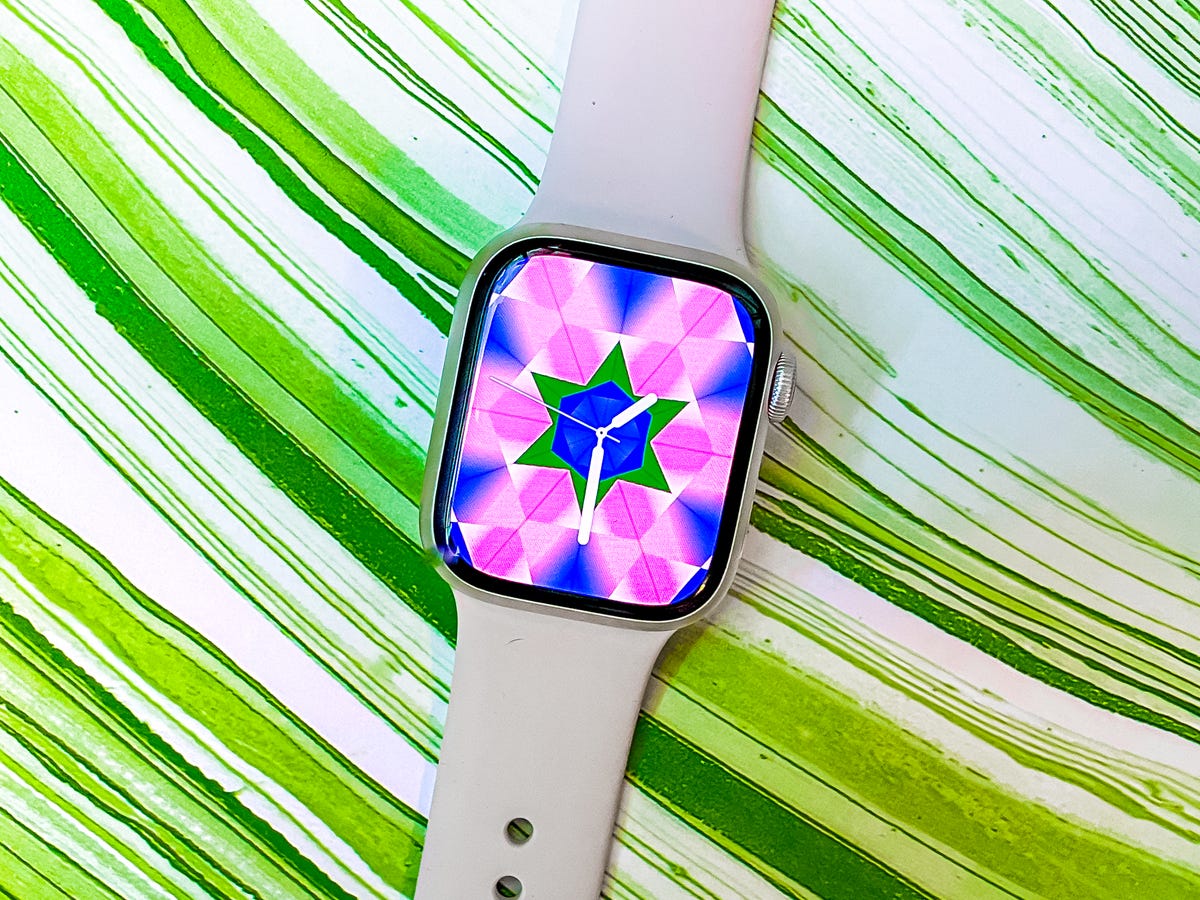
The Apple Watch Series 7's biggest update is its larger screen.
Lisa Eadicicco/CNETThe Series 7's larger display is the biggest change that differentiates it from the Series 6. Apple has reduced the size of the borders that frame the screen to allow for a more spacious display without meaningfully changing the casing's dimensions.
As a result, the Apple Watch Series 7 comes in 41-millimeter and 45mm size options, compared to the Series 6 which was available in 40mm and 44mm casings. The watch itself is technically a little heavier too; the aluminum 41mm model weighs 32 grams compared to the 30.5-gram 40mm Series 6. However, this wasn't noticeable while wearing the watch.
Read more: Best Apple Watch Series 7 Cases
The Series 7 also has IP6X dust resistance and a front crystal cover that's more than 50% thicker, although I haven't had the opportunity to put that to the test just yet. But the Series 7 held up just fine when CNET senior video producer Chris Parker tested its dust and water resistance, which you can learn more about in the video below.
The corners are also softer and more round, but you can really only notice this when examining the watch very closely. The aluminum model also comes in five new colors: midnight, starlight, green and updated blue and red options that are lighter compared to the shades that were available for the Series 6. I've been wearing the starlight model, which is like a blend of gold and silver.
You might be wondering why you even need a larger screen on a device like the Apple Watch, which is meant for short glanceable notifications rather than long interactions. Apple has made a few attempts at answering that question by redesigning the watch's user interface to make sense of its bigger screen.
Buttons in apps like timers, alarms and the calculator have been enlarged so that they're easier to tap. The most useful change in this sense is the keypad for unlocking your watch. Now that the buttons are larger, I can type in my passcode correctly on the first try when putting on my watch in the morning even when I'm in a hurry.
You can also see a couple of extra lines of text on screen when reading news clips or notifications. While it's a noticeable improvement, it didn't meaningfully change how I use the Apple Watch since I don't typically do a lot of reading on its screen.
The Series 7 also includes new font size options for making text appear even larger on screen, which could be particularly useful for watch owners with visual impairments.
The Apple Watch finally gets its first real keyboard

The Apple Watch Series 7 is the first to get a QWERTY keyboard.
Lisa Eadicicco/CNETHowever, the new QWERTY keyboard is the real reason you'll benefit from the Series 7's larger screen. In apps like Messages or Mail, simply tap the message field when creating a new text or email to pull up the keyboard. If you don't see the keyboard right away, you can use the arrow at the bottom of the screen to switch between the keyboard option or Scribble, which lets you trace individual letters with your finger.
The keyboard's autocorrect functionality works surprisingly well, which is important on such a tiny keyboard where it's difficult to be precise. I was impressed by the way it often correctly completed my words before I had finished typing, even when I was typing something very specific like a friend's name.
This really came in handy when I attended a close friend's wedding recently as a bridesmaid. There were several occasions in which I needed to coordinate with other wedding party members but didn't have my phone nearby. Instead of running down the hallway in my heels to grab my phone from the bridal suite, I sent a quick message to my husband that said "Come down to the lobby," when I had some down time between photo shoots.
I've mostly been using the QuickPath feature, which lets you type by swiping between letters, since it's much easier to slide my finger across the Series 7's keyboard rather than pecking individual keys.
Of course, you could also use the watch's dictation feature to send messages without reaching for your phone. But not everyone feels comfortable talking into their watch in public and there may be times when a message is simply too private to dictate out loud.
It's great to finally have a native text input method on the Apple Watch that's feasible for typing out full words and sentences, unlike the Scribble feature. That being said, if you're typing anything more than a short phrase like "Meet me downstairs," or "Don't forget the milk," it's best to use your phone.
Typing on the watch requires too much concentration for lengthy sentences. I also often found myself deleting full words when I meant to only erase one character, which can be frustrating. (You can change this in the watch's settings or use the digital crown to move the cursor more precisely).
New watch faces show how the bigger screen can be useful, but there should have been more
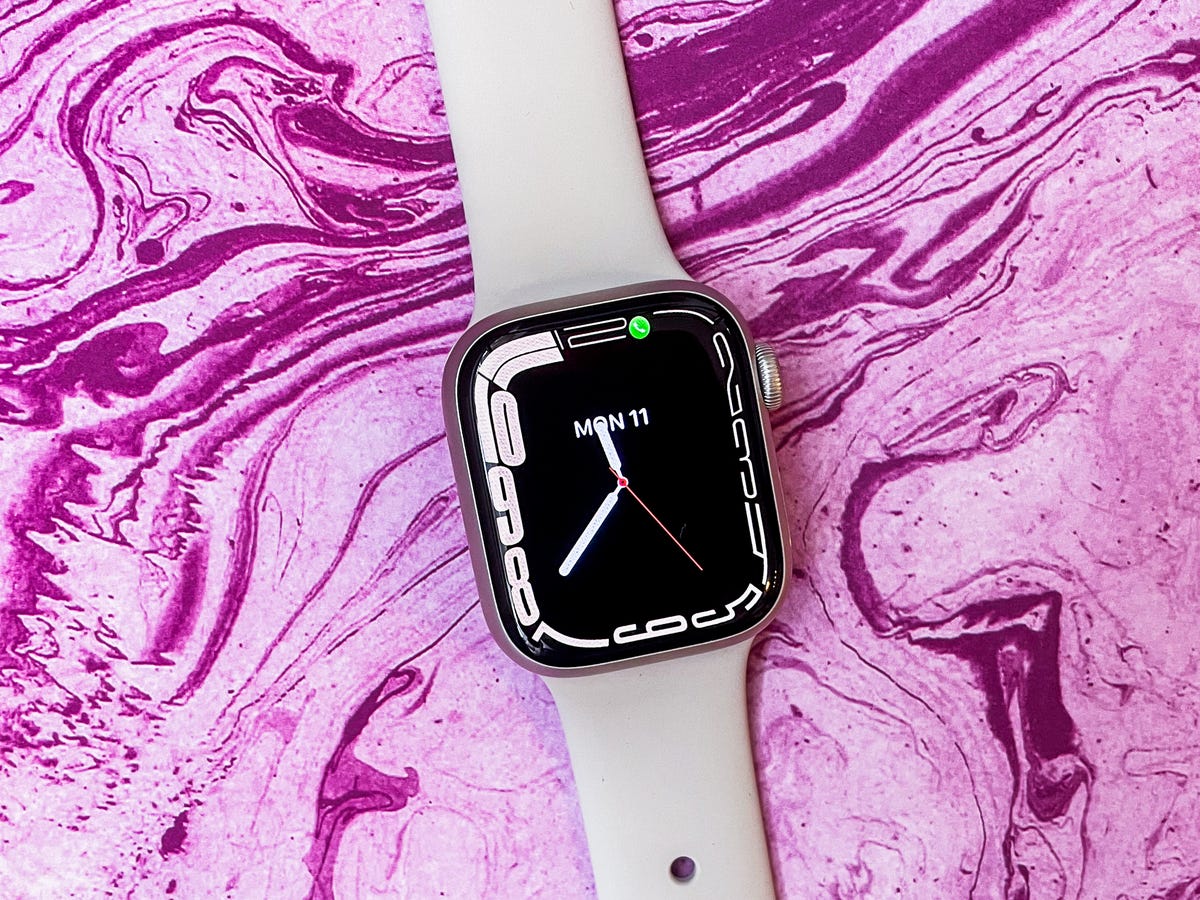
The Apple Watch Series 7 has a new Contour watch face designed for its larger screen.
Lisa Eadicicco/CNETWatch faces are a big part of the Apple Watch experience since it's the screen you look at the most. With that in mind, it's no surprise that Apple has added new watch faces designed specifically for the Series 7's bigger display. There's the Modular Duo face, which is the first to have two large-format complications for displaying information and Contour, a face featuring numerals that bleed over the Series 7's curved edges.
I personally preferred the Modular Duo face since getting as much information as possible in a quick glance is more important to me than aesthetics. With the Modular Duo face, I'm able to see the time, a breakdown of my activity progress over the course of the day, the temperature and hourly weather forecasts just by looking down at my wrist. The regular Modular face available on the Series 6 and earlier, by comparison, only lets you add one large complication and several small ones.
I only wish there were more faces to choose from that have been specially designed for the Series 7 -- especially since the larger screen is its most significant upgrade. Hopefully we'll see more new watch faces arrive in future software updates.
The other major change Apple has made to the display is increasing its brightness in always-on mode while indoors. That means when your wrist is down and the display is inactive, the Series 7's screen will shine brighter than the Series 6's and the Series 5's. It's definitely noticeable when comparing the Series 7 and Series 6 side-by-side, but it doesn't make a substantial difference in the way I use my watch. Consistent with my overall thoughts on the Series 7, the brighter always-on display is a refinement rather than a major upgrade.
Faster charging but the same battery life
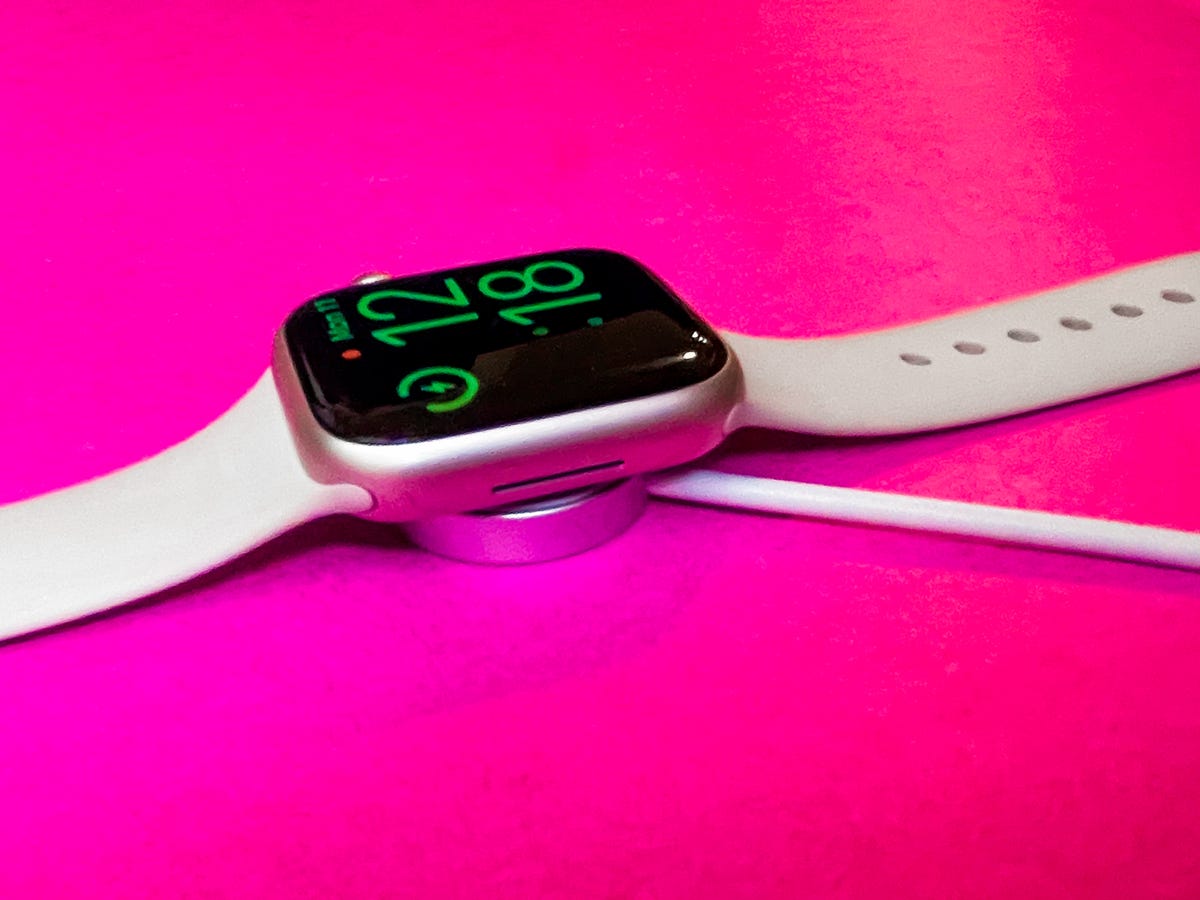
The Apple Watch Series 7's new charger enables it to charge 33% faster than the Series 6.
Lisa Eadicicco/CNETWhen it comes to battery life, there's good news and bad news. The good news is that the Series 7 can charge considerably faster than the Series 6, which is useful if you use the watch for sleep tracking or simply forget to charge it overnight. The bad news: The Series 7's battery life hasn't improved compared to the Series 6.
Let's start with the good. Apple says the new watch should charge up to 33% faster than its predecessor thanks to changes made to the watch's internals and a new charger that comes in the box.
I found this to be accurate during my testing, but only when charging the watch for at least a half hour. After 30 minutes of charging, the Apple Watch Series 7's battery jumped from zero to 54%, while the Series 6's only replenished by 37% in the same time period. For consistency, I used the same charger for both watches.
That's a big difference and those who charge up their watch during their morning routine before leaving the house will surely appreciate it. But if you only have a few spare moments to power up your watch, there isn't much of a difference in charging speed between the Series 6 and Series 7. After charging both watches on the same charger for 15 minutes, the Series 7's battery was at 24% while the Series 6's was at 23%.
The other downside is that this only works with Apple's new charger. That means if you have a charging dock with a built-in Apple Watch charger like Apple's MagSafe Duo, you won't be able to take advantage of the Series 7's speedier power-up process. However, the faster charger will work with any USB-C compliant wall adapter, whether it's made by Apple or not.
Apple also hasn't improved the Apple Watch's battery life with the Series 7. Like its predecessor, the Series 7 should last for 18 hours on a single charge according to Apple's estimates. Instead of improving the watch's overall battery life, Apple is seemingly trying to make topping off the battery throughout the day easier so that you don't have to charge it overnight.
Battery life will always vary depending on how you use your watch, but I've found that the Series 7 and Series 6 generally last for about a day and a half with the always-on display setting turned on. Activities like running with GPS will cause it to drain faster.
Considering Fitbit watches like the Versa 3 and Sense offer multiday battery life, it would have been nice to see Apple make some advancements on this front. That's especially true since Apple is now positioning the Apple Watch as a sleep tracker. There's a lot of room for the Apple Watch to improve as a sleep tracker, which Apple has proven by adding new metrics such as sleeping respiratory rate in WatchOS 8. I'm just disappointed it didn't extend battery life to match.
The same sensors and health tracking as the Series 6

The Apple Watch Series 7 has the same health tracking features as the Series 6.
Lisa Eadicicco/CNETAside from these changes, the Series 7 has a lot in common with the Series 6. The Series 7 runs on a new S7 system-on-a-chip, but offers the same performance as the Series 6.
Both watches have support for blood oxygen saturation measurements, the ability to take an ECG from the wrist, heart rate measurements with high and low heart rate notifications, a compass for more precise location tracking, an always-on altimeter for measuring elevation, fall detection, Apple's U1 chip that helps the watch function as a digital car key, emergency SOS and international emergency calling. That's in addition to features that have been in the Apple Watch for years, like Apple Pay.
In fact, you don't even need the latest Apple Watch to get many of the device's latest features. Apple's WatchOS 8 software, which launched on Sept. 20, brings a bunch of new capabilities to watches as old as the Series 3.
These include more advanced fall detection that can tell if you've taken a tumble from a specific type of workout like cycling, the ability to store digital versions of your ID and house key on the watch, the ability to use Portrait mode photos as your watch face and a new Mindfulness app that replaces the Breathe app. The same selection of workout modes and compatibility with Apple Fitness Plus is also available across Apple Watch models.
It's important to note, however, that not all the new features in WatchOS 8 are available on all models that support the software. A feature that detects when you start cycling and prompts you to begin a workout on the watch is only available on the Apple Watch SE, Series 6 and Series 7, while the updated fall detection only works on the Series 4 or later.
The bottom line: A small improvement from the Series 6
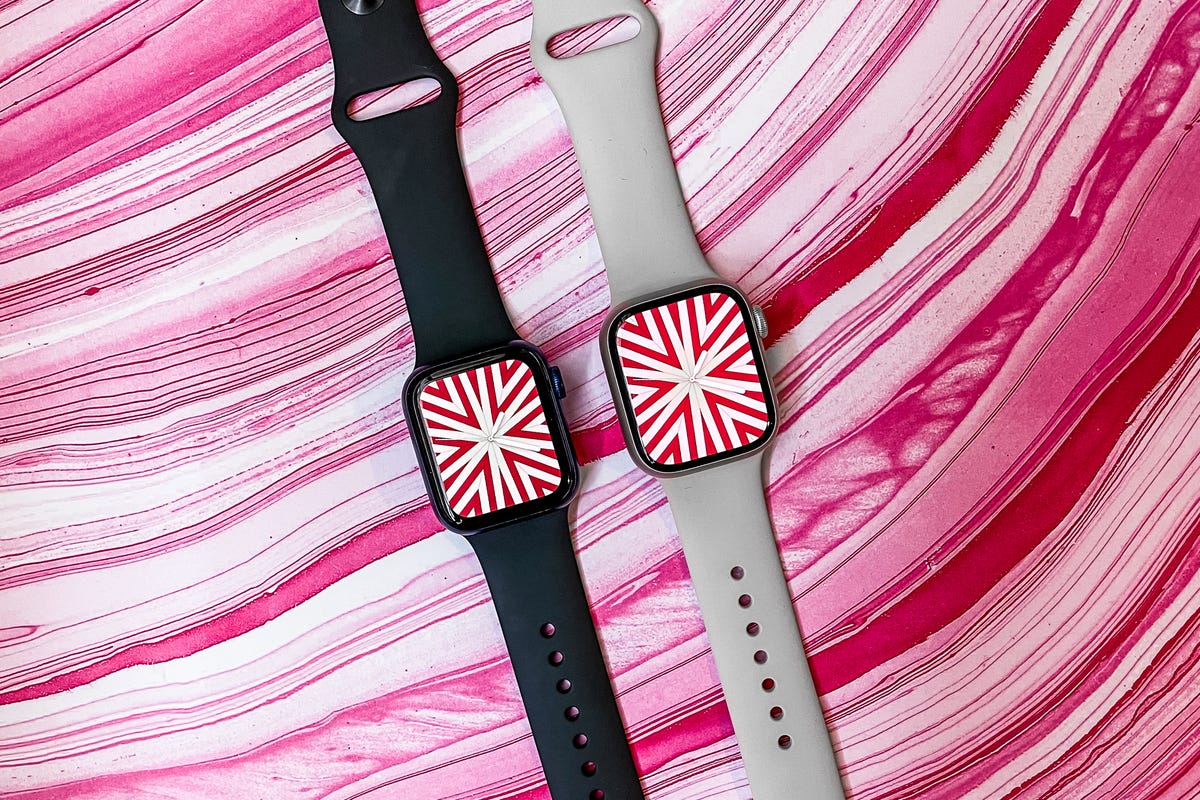
The Apple Watch Series 6 (left) alongside the Apple Watch Series 7 (right).
Lisa Eadicicco/CNETOverall, the Apple Watch Series 7 feels more like a theoretical Apple Watch 6S rather than a major year-over-year upgrade. Apple isn't bringing anything entirely new to the health experience with the Series 7 as it did with last year's Series 6, which was the first Apple Watch to support blood oxygen saturation measurements.
There are pros and cons to that approach. I'm glad Apple isn't just adding new health features for the sake of outpacing the competition. My biggest criticism about new wellness capabilities from Fitbit and Amazon -- such as Fitbit's app for testing your body's reaction to stress and Amazon's body-scanning tech that estimates body fat percentage -- is that there isn't enough direction about how to interpret these readings. Without knowing what to do with that information, it's hard to know how these data points can be helpful. So in that regard, it's great to see Apple expanding the watch's health tracking capabilities in more practical and straightforward ways, such as by adding better fall detection and new workout options with WatchOS 8.
But at the same time, I would have liked to see more from the Series 7. Longer battery life is always on my wishlist, but Apple could have also done more to leverage the Series 7's existing technology. A broader selection of new watch faces designed to take advantage of the Series 7's larger screen would have been nice. And more than a year later, I'm still not entirely sure what to make of the results from the watch's blood oxygen sensor. We also expected to see an upgraded U1 ultrawideband chip in the Series 7 per a Bloomberg report that was published ahead of the watch's launch, but that didn't arrive either.
All told, the Apple Watch Series 7 is essentially a more refined version of the Series 6. If you already have a recent watch like the Series 5 or 6, there's no reason to upgrade just yet -- especially since you can get many new features through software updates. But if you have an older watch like the Series 3 or Series 4, you'll have a lot to gain from the bigger screen, speedier performance and additional sensors that come with the Series 7.
Apple Watch Series 7 vs. Series 6, SE, Series 5, Series 3
| | Apple Watch Series 7 | Apple Watch Series 6 | Apple Watch SE | Apple Watch Series 5 | Apple Watch Series 3 |
|---|---|---|---|---|---|
| Size | 41mm/45mm | 40mm/44mm | 40mm/44mm | 40mm/44mm | 38mm/42mm |
| Display | Always-on Retina display with nearly 20% more screen area than Series 6 | Always-on Retina display | Retina display | Always-on Retina display | Retina display |
| Display resolution | 352 x 430 (41mm), 396 x 484 (45mm) | 324 x 394 (40mm); 368 x 448 (44mm) | 324 x 394 (40mm); 368 x 448 (44mm) | 324 x 394 (40mm); 368 x 448 (44mm) | 272 x 340 (38mm); 312 x 390 (42mm) |
| Durability | Water resistance; IP6X dust resistance | Water resistance | Water resistance | Water resistance | Water resistance |
| Sensors | Blood oxygen, electrical heart, third-gen optical heart, compass, always-on altimeter, fall detection, accelerometer, gyroscope, GPS/GNSS, ambient light | Blood oxygen, electrical heart, third-gen optical heart, compass, always-on altimeter, fall detection, accelerometer, gyroscope, GPS/GNSS, ambient light | Second-gen optical heart, compass, always-on altimeter, fall detection, accelerometer, gyroscope, GPS/GNSS, ambient light | Second-gen optical heart, electrical heart, compass, barometric altimeter, fall detection, accelerometer, gyroscope, GPS/GNSS, ambient light | Optical heart, barometric altimeter, accelerometer, gyroscope, GPS/GNSS, ambient light |
| Processor | S7 | S6 | S5 | S5 | S3 |
| Colors and finishes | Aluminum: midnight, starlight, green, blue red; stainless steel: silver, graphite, gold; titanium: natural, space black | Aluminum: silver, space gray, gold, blue, red; stainless steel: silver, graphite, gold; titanium: natural, space black | Aluminum: space gray, silver, gold | Aluminum: silver, space gray, gold; stainless steel: stainless steel, space black, gold; titanium: natural, space black; ceramic: white | Aluminum: space gray, silver |
| Battery Life | Up to 18 hours with 33% faster charging than Series 6 | Up to 18 hours | Up to 18 hours | Up to 18 hours | Up to 18 hours |
| Storage | 32GB | 32GB | 32GB | 32GB | 8GB |
| Connectivity | Wi-Fi, Bluetooth 5.0, W3 wireless chip, U1 chip, emergency SOS, international emergency calling, optional LTE | Wi-Fi, Bluetooth 5.0, W3 wireless chip, U1 chip, emergency SOS, international emergency calling, optional LTE | Wi-Fi, Bluetooth 5.0, W3 wireless chip, emergency SOS, international emergency calling, optional LTE | Wi-Fi, Bluetooth 5.0, W3 wireless chip, emergency SOS, international emergency calling, optional LTE | Wi-Fi, Bluetooth 4.2, W2 wireless chip, emergency SOS |
Source
Blog Archive
-
▼
2023
(68)
-
▼
February
(19)
- YouTube Names The Top 10 Most-viewed Videos Upload...
- Are We In A Recession? Here's What You Should Know...
- Should You Buy Used Camera Gear?
- DJI's Compact, Folding OM 5 Stabilizing Gimbal For...
- Apple Watch 7 Review: A Slight Upgrade Compared To...
- Best Money Tips For Gen Xers In A Shaky Economy
- Xiaomi Redmi 2 Review: Value, But Not Without Cost
- Magic Leap 2 AR Headset Arrives Sept. 30, Starting...
- 2022 Kia Carnival Long-Term Update: Detroit To LA ...
- Hisense Chromebook Review: A Cheap Chromebook That...
- Thunderstorms Delay, Cancel Thousands Of US Flight...
- Tesla Faces More Lawsuits Alleging Sexual Harassme...
- Twitter Unveils Plan To Combat Misinformation In 2...
- Get This Lenovo Chromebook 3 For Just $79, A Disco...
- 10 Apps For Editing Photos Before You Post To Inst...
- Qualcomm's New W5 Chips Could Bring Better Battery...
- Google Pixel 6 And Pixel 6 Pro Models Drop To All-...
- Qualcomm's New Snapdragon 8cx Gen 3 Aims To Create...
- Apple's MacBook Pro Models With M1 Pro Chip Hit Ne...
-
▼
February
(19)
Total Pageviews
Search This Blog
Popular Posts
-
Dji om 5 gimbal stabilizer dji om 5 smartphone gimbal stabilizer review dji om 5 handheld gimbal dji om 5 gimbal review dji om 4 handheld fo...
-
Apple watch 7 review a slight upgrade compared with crossword apple watch 7 review a slight upgrade compared in spanish apple watch 7 review...
-
Mlb the show review mlb tv season subscription mlb tv subscription uk mlb tv login mlb tv media player mlb tv canada mlb tv 2022 mlb tv app ...
